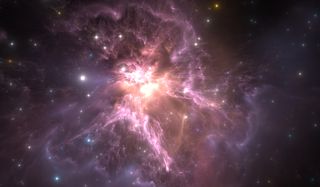This Image Emits Dark Energy Funny
What Is Dark Energy?

Dark energy is an enigmatic phenomenon that acts in opposition to gravity and is responsible for accelerating the expansion of the universe. Though dark energy constitutes three-fourths of the mass-energy of the cosmos, its underlying nature continues to elude physicists. Dark energy has no real connections to dark matter, beyond sharing the word dark, which just means that scientists don't really know what these things are.
Who discovered dark energy?
The realization that the universe is expanding can be traced back to the American astronomer Edwin Hubble, who noticed, in 1929, that the farther a galaxy is from the Earth, the faster it is moving away from us, according to the Hubble Space Telescope website. This doesn't mean that our planet is the center of the universe, but rather that everything in space is moving away from everything else at a constant rate.
Nearly 60 years after Hubble's revelation, scientists made another startling discovery. Researchers had long been trying to precisely measure cosmic distances by looking at the light of faraway stars. In the late 1990s, after examining distant supernovas, two independent teams found that the stellar explosions' light is dimmer than expected. This indicates that the universe is not only expanding, but also accelerating in its expansion.
That finding has given physicists cause to scratch their heads ever since then, also earning its discoverers the Nobel Prize in physics in 2011.
What does dark energy do?
Though researchers don't entirely understand dark energy, they have used their knowledge of the phenomenon to construct models of the universe that explain everything from the Big Bang to the modern-day large-scale structure of galaxies. Some of these models predict that dark energy will rip apart everything in existence billions of years from now.
The leading explanation of dark energy suggests that it is a type of pent-up energy inherent in the fabric of space-time. "This simple model works very well practically, and it is a straightforward addition to the cosmological model without having to modify the law of gravity," Baojiu Li, a mathematical physicist at Durham University in the United Kingdom, previously told Live Science. But the idea comes with one major problem: Physicists predict that the value of the vacuum's energy should be 120 orders of magnitude higher than what cosmologists observe in measurements, Li said.
An alternative idea posits that dark energy is an additional fundamental force, joining the four already known (gravity, electromagnetism, and the strong and weak nuclear forces). But this conjecture doesn't explain why humans don't notice this extra force in our day-to-day lives. So, theorists have also built creative models suggesting that this mysterious force is hidden in some way.
The measured value of dark energy is currently the subject of an intense debate between rival factions in physics. Some researchers have measured dark energy's power using the cosmic microwave background, a dim echo of the Big Bang, and produced one estimate.
But other astronomers, who measure dark energy's strength using the light of distant cosmic objects, have produced a different value, and nobody has yet been able to explain the discrepancy. Some experts have suggested that dark energy's power varies over time, though proponents of that idea have yet to convince a majority of their peers of this explanation.
Additional resources:
- Read more about dark energy from Swinburne University in Australia.
- Here's the definition of dark energy and dark matter, from NASA Science.
- Watch "Big Mysteries: Dark Energy," from Fermilab.
Source: https://www.livescience.com/what-is-dark-energy.html
0 Response to "This Image Emits Dark Energy Funny"
Post a Comment